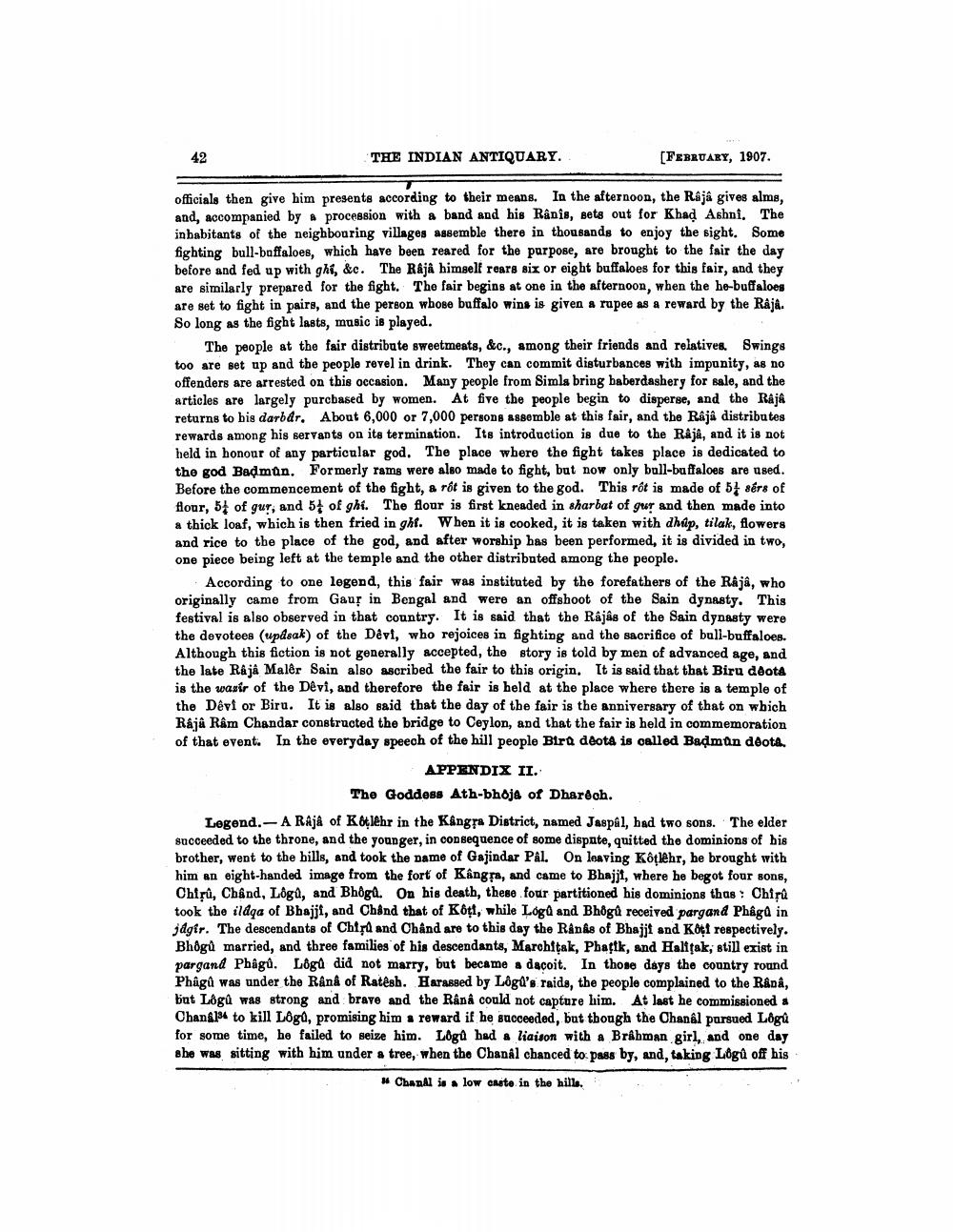________________
42
THE INDIAN ANTIQUARY.
[FEBRUARY, 1907.
officials then give him presents according to their means. In the afternoon, the Raja gives alms, and, accompanied by a procession with a band and his Rânis, sets out for Khad Ashni. The inhabitants of the neighbouring villages assemble there in thousands to enjoy the sight. Some fighting bull-baffaloes, which have been reared for the purpose, are brought to the fair the day before and fed up with ghí, &c. The Râjâ himself rears six or eight buffaloes for this fair, and they are similarly prepared for the fight. The fair begins at one in the afternoon, when the he-buffaloes are set to fight in pairs, and the person whose buffalo wins is given a rupee as a reward by the Rája. So long as the fight lasts, music is played.
The people at the fair distribute sweetmeats, &c., among their friends and relatives. Swings too are set up and the people revel in drink. They can commit disturbances with impunity, as no offenders are arrested on this occasion. Many people from Simla bring baberdashery for sale, and the articles are largely purcbased by women. At five the people begin to disperse, and the Rajá returns to bis darbdr. About 6,000 or 7,000 persons assemble at this fair, and the Raja distributes rewards among his servants on its termination. Its introduction is due to the Raja, and it is not held in honour of any particular god. The place where the fight takes place is dedicated to the god Badman. Formerly rams were also made to fight, but now only ball-buffaloes are used. Before the commencement of the fight, a rôt is given to the god. This rôt is made of 54 sérs of flour, 54 of gur, and 5 of ghi. The four is first kneaded in sharbat of gur and then made into a thick loaf, which is then fried in ghf. When it is cooked, it is taken with dhép, tilak, flowers and rice to the place of the god, and after worship has been performed, it is divided in two, one piece being left at the temple and the other distributed among the people.
According to one legend, this fair was instituted by the forefathers of the Raja, who originally came from Gaur in Bengal and were an offshoot of the Sain dynasty. This festival is also observed in that country. It is said that the Râjâs of the Sain dynasty were the devotees (updsak) of the Devi, who rejoices in fighting and the sacrifice of ball-buffaloes. Although this fiction is not generally accepted, the story is told by men of advanced age, and the late Råjå Malêr Sain also ascribed the fair to this origin. It is said that that Biru ddota is the wasir of the Devi, and therefore the fair is held at the place where there is a temple of the Devi or Biru. It is also said that the day of the fair is the anniversary of that on wbich Rája Râm Chandar constructed the bridge to Ceylon, and that the fair is held in commemoration of that event. In the everyday speech of the hill people Bira deota is oalled Bağman deota.
APPENDIX II.
The Goddess Ath-bhoją of Dharéch. Legend.- A RAJA of Kotlêhr in the Kangra District, named Jaspal, had two sons. The elder succeeded to the throne, and the younger, in consequence of some dispate, quitted the dominions of his brother, went to the bills, and took the name of Gajindar Pål. On leaving Kôtlehr, he brought with him an eight-handed image from the fort of Kangrs, and came to Bhajjt, where he begot four sons, Chirů, Chånd, Logů, and Bhögu. On his death, these four partitioned his dominions thas: Chiru took the ildqa of Bhajji, and Chånd that of Koti, while Loga and Bhögû received pargand Phậga in jagir. The descendants of Chird and Chand are to this day the Ranks of Bhajjt and Kot respectively. Bhögů married, and three families of his descendants, Marchiţak, Phaçik, and Halttak, still exist in pargand Phágú. Logu did not marry, but became a dacoit. In those days the country round Phagû was under the Rank of Ratesh. Harassed by Lôgu's raids, the people complained to the Râpâ, but Lögû was strong and brave and the Rânâ could not capture him. At last he commissioned a Chang134 to kill Logo, promising him a reward if he succeeded, but though the Chanel pursued Logu for some time, he failed to seize him. Lögu had a liaison with a Brahman girl, and one day she was sitting with him under a tree, when the Chanál chanced to pass by, and, taking Logů off his
# Chanal is a low caste in the hills.




